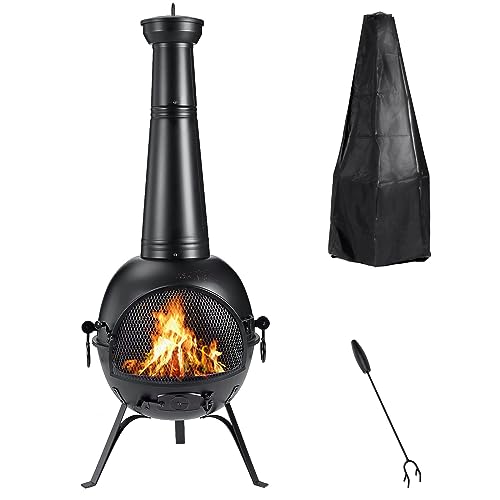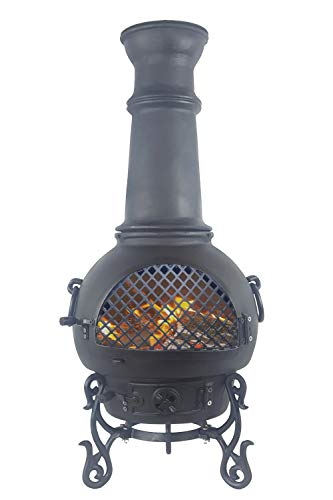Let's Get It Out Of The Way! 15 Things About Mexican Chimineas We're T…
페이지 정보

본문
 Chimineas - An Authentic Mexican Fire Pit
Chimineas - An Authentic Mexican Fire PitThe first time they were used was as bread ovens, chimineas reflect Mexico's rich cultural heritage. The simple design, blending practicality and aesthetics, is timeless.
Clay chimineas can be fired in kilns which remove organic matter from the clay and seals the pores to prevent cracking. They are made to be outdoors all year round, but should be protected from long-term exposure to the elements.
Origins
Imagine a balmy evening in the summer with family and friends eating delicious food outside and being warm by your Mexican or clay chiminea. This scene is reminiscent of the Mexican origins of this kind of outdoor fireplace.
The terracotta stoves of the past were designed to function as radiant heaters and ovens. They helped tribesmen to survive the cold winter nights in their homeland. Their distinctive shape was influenced by their utilitarian values that focused on practicality and social living.
These stoves were initially constructed from natural terra-cotta clay that was dried and wood-fired in kilns. Chimineas made from big clay chiminea have a more rustic appearance and were not coated to protect the surface. Modern manufacturers make chimineas out of metals, such as aluminum, cast iron and brass. These materials provide better durability and weather resistance, addressing one of the major weaknesses of the clay design.
The distinctive design of the chiminea was inspired by a pot-bellied base that rises to an extended fireplace. This design is a great method of containing a fire whilst directing the smoke upwards, which reduces the possibility of air inhalation and enhances heat retention.
Chimineas were used for cooking for heating, cooking and also to provide light for the tribes of Mexico. Today, we can appreciate them for their aesthetic qualities and the warmth they provide on cold autumn evenings, and even in chilly winter sun.
Gardeco has a range of styles that will suit your garden. We have a variety of sizes, from small and medium to large and jumbo. We also stock clay chimineas that are decorated with either engraving or a moulded design.
Our selection of terracotta and Mexican Chimineas is made by artisans in the middle of the country. The colours and shapes can vary slightly due to the nature of the manufacturing process. You can always repaint your chiminea using an emulsion paint that's water-based in the event that it begins to turn discoloured. Before you begin using your new chiminea it is essential to read all instructions and tips on care given by the manufacturer.
Design
Chimineas not only add character and warmth to any space, but they are also practical. They are available in various materials and designs and can be matched to any furniture for your patio. They can be used as a focal point or blend seamlessly with your landscape.
 The traditional chimenea, made out of clay, was conceived with both practical and cultural significance in mind. The tall chimney-like neck directed smoke away from users, while its rounded body radiated warmth. It was also used to socialize and tell stories, playing an important place in Mexican and Central American cultures.
The traditional chimenea, made out of clay, was conceived with both practical and cultural significance in mind. The tall chimney-like neck directed smoke away from users, while its rounded body radiated warmth. It was also used to socialize and tell stories, playing an important place in Mexican and Central American cultures.Traditionally, chimineas were handcrafted by local artisans using wet clay chiminea fire pit that was taken directly from the ground. The clay was then formed into its final form prior to being dried by kiln. The process of creating the clay chimenea was very labor-intensive, particularly for the huge ones. Typically the potters would roll long snakes of clay into a cylinder shape and then smooth the clay and create the chiminea's bowl as well as neck. The rim of the clay is often decorated with carvings or patterns.
A modern chiminea is typically made of metal such as cast iron or aluminum. The introduction of metal chimineas was an important evolutionary step because they are able to withstand high temperatures and moisture without cracking. This allowed chimineas to be used in many different climates.
Although there are still several companies that produce clay and terracotta chimineas most chimineas now are made from metal. The advantages of a metal chiminea include its capability to withstand higher temperatures, as well as the fact that it can be cleaned more easily. These advantages have made metal chimineas more popular than their clay counterparts.
No matter which kind of chiminea you pick it's important to place it in the right spot. It should be positioned in a level space and away from any flammable objects such as grass, trees or other structures. The chiminea should also be set on a concrete, brick or stone patio and never on a wooden deck. It's also a good idea to place 50mm of sand, or Gardeco Lava Stones under the chiminea. This will protect it from direct heat.
Materials
Traditional clay and terracotta chimineas, which are still made by small chiminea-scale factories today, are kiln fired to temperatures up to 1000c. After they have cooled and dried, the chimineas are able to be assembled. Some are coated with glazes, while others are unglazed. Chimineas are a very popular choice because they provide the authentic Mexican style to your garden.
Chimineas can be painted by hand in a variety of colours and patterns to fit different styles. The paint finish will fade due to time and heat of the fire so it's best to re-paint with an emulsion based on water.
In the beginning, they were designed to provide heating and cooking facilities for Mexicans living in towns, chimineas through the years have transformed into a symbol of culture, adjusting their function to accommodate a variety of needs. In addition to serving as bread ovens for the indigenous people of Mexico These distinctive structures also played a crucial role in repelling insects as well as in promoting social gatherings.
The unique design of a chiminea featuring a wide base and narrow chimney spout allows for the maximum amount of air to be drawn into the bottom of the structure, minimizing smoke inhalation. It also helps retain the heat inside the chiminea's belly. This makes it ideal for cooking.
Chimineas are found in many different materials like terracotta clay, cast iron and even aluminium. Terracotta chimineas offer a classic Mexican style. They are susceptible to cracking when under pressure, and should only be placed on a flat surface that is fire-proof. cast aluminum chiminea iron and aluminum chimineas aren't as susceptible to damage, while remaining elegant and durable.
To make sure the chiminea lasts as long as you can, place it in a location that is well ventilated and shielded from wind and rain. It should be placed away from walls and structures that could catch fire, and also the roofs of patios and eaves that may be damaged by a sudden shift in temperatures when the chiminea has been extinguished. To avoid the chiminea burning excessively it is recommended that only dried, seasoned logs are burned. Regular cleaning using a wire brush is important, as it will stop the accumulation of deposits that could cause the chiminea to burn and blacken. The chiminea can be protected from wind, which will reduce the amount of smoke it releases.
Maintenance
As with any fire equipment it is important to maintain it properly to ensure the longevity of your Chiminea. This will prolong its lifespan and ensure that it is operating safely. Chimineas can be fragile, and should be kept outside where they can be cared for. Even though a clay chiminea appears sturdy, it can still crack and break from a variety of sources. It is crucial to examine your chiminea for signs of wear and follow the manufacturer's guidelines on how often to use it.
To keep your mexican chimney looking great it is essential to clean it thoroughly with mild detergent. This will eliminate any built-up dirt and grime, which can lead to discoloration and corrosion. To remove the rusty particles that are loose, make use of a wire brush. It is recommended that goggles and gloves are worn to protect yourself. After scrubbing, rinse the chiminea, and let it dry completely. This will keep any moisture from causing corrosion and can greatly prolong the life of your chiminea.
After your chiminea has been cleaned and dried, it can be lightly sanded with fine-grit sandpaper. This will smooth the surface and remove any rough spots that could attract embers if you decide to build a fire. The sanding will also help make the surface more even and attractive. The sanding process can be followed by several coats of grill or stove paint to improve the appearance and ensure that your chiminea is protected from rust.
It is also recommended to keep your chiminea out of direct sunlight and wind, as this can cause the paint to fade and peel. It is possible to solve the issue by using water-based emulsions paints or masonry spray. It is also crucial to only add a small amount of wood at a time, and make small fires in your chiminea in order to "break it in" and prevent overheating.
- 이전글Six Trendy Concepts For your High Stakes Poker 24.10.31
- 다음글7 Tips About Chiminea Fire Pit That Nobody Will Share With You 24.10.31
댓글목록
등록된 댓글이 없습니다.
